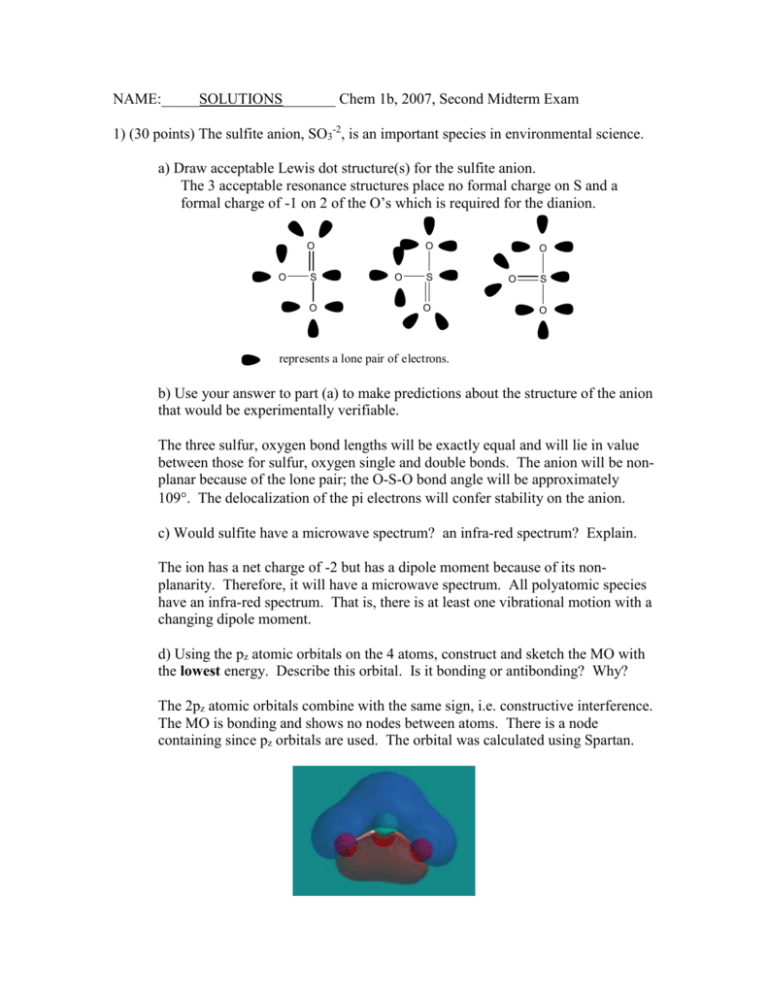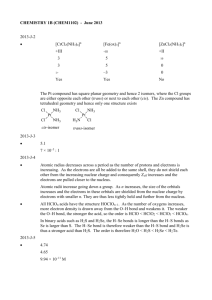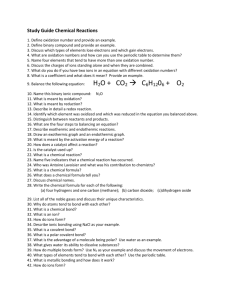NAME: Chem 1b, 2007, Second Midterm Exam
advertisement

NAME:_____SOLUTIONS_______ Chem 1b, 2007, Second Midterm Exam 1) (30 points) The sulfite anion, SO3-2, is an important species in environmental science. a) Draw acceptable Lewis dot structure(s) for the sulfite anion. The 3 acceptable resonance structures place no formal charge on S and a formal charge of -1 on 2 of the O’s which is required for the dianion. O O S O O O S O O O S O represents a lone pair of electrons. b) Use your answer to part (a) to make predictions about the structure of the anion that would be experimentally verifiable. The three sulfur, oxygen bond lengths will be exactly equal and will lie in value between those for sulfur, oxygen single and double bonds. The anion will be nonplanar because of the lone pair; the O-S-O bond angle will be approximately 109. The delocalization of the pi electrons will confer stability on the anion. c) Would sulfite have a microwave spectrum? an infra-red spectrum? Explain. The ion has a net charge of -2 but has a dipole moment because of its nonplanarity. Therefore, it will have a microwave spectrum. All polyatomic species have an infra-red spectrum. That is, there is at least one vibrational motion with a changing dipole moment. d) Using the pz atomic orbitals on the 4 atoms, construct and sketch the MO with the lowest energy. Describe this orbital. Is it bonding or antibonding? Why? The 2pz atomic orbitals combine with the same sign, i.e. constructive interference. The MO is bonding and shows no nodes between atoms. There is a node containing since pz orbitals are used. The orbital was calculated using Spartan. 2) (20 points) Draw acceptable Lewis dot structures for three isomers of C4H7NO. Many isomers without formal charge are possible. Here are just a few of the many possibilities. Cis and trans isomerism is possible for several of the isomers shown below. O O N H N H O O NH2 NH2 OH NH NH2 OH 3) (15 points) Select one of the isomers that you submitted in your answer to question (2). Answers are given for the following trans isomer from the list in (2). All atoms as well as lone pairs are shown. Counting from the left, the heavy atoms are N1, C1, C2, C3, C4, O H H H H H O N H H a) Predict its three-dimensional structure. The isomer is non-planar. However, C2, C3, C4, O, and the H’s attached to them as well as C1 lie in a plane. HNC1 109, HC1H 109, NC1C2 109 C1C2C3 120, C2C3C4 120, C3C4O 120, C3C4H 120 r(C1,C2; single bond)>r(C3,C4;delocalization)<r(C2,C3; double bond) b) Provide the hybridization of each heavy atom. N1 and C1: sp3; C2, C3, C4, and O: sp2 c) Are conformers possible for this isomer? Explain. Yes. The NC1, C1C2, and C3C4 bonds are single bonds and rotation about them is facile as bond breaking is not involved. Several distinct structures are possible that minimize the interatomic interactions. 4) (20 points) The normal melting points of CrF2, CrF3, CrF4, and CrF5 are 894C, 1400C, 277C, and 34C, respectively. Provide a rationalization for this set of data with the aid of bonding theory. The normal melting points fall into a low-melting set represented by CrF4 and CrF5 and a high melting set represented by CrF2 and CrF3. The bonding models in the two sets are covalent and ionic, respectively. Consider CrF2 first; it is a very favorable candidate for ionic bonding. Chromium is a metal and the loosely held 4s electrons are easily ionized. Fluorine has a large electron affinity, i.e. the fluoride anion has a large ionization energy. The Coumbic attraction is enhanced by the +2 charge on the chromium(II) cation. Ionic bonding is also favorable energetically in the case of CrF3. One additional electronic must be ionized but the Coulombic attraction is enhanced by an increased charge and decreased size of the Cr(III) cation. However, as we progress to higher fluorides of chromium, the energetic cost of removing a fourth and a fifth electron from chromium is too high and the thermodynamic cycle yields an unfavorable positive value for the energy change. The compounds do exist and so covalency provides the mechanism for bonding. 5) (15 points) Are stable molecular species containing the element helium possible? Provide a rationale for your answer. MO theory provides a convincing demonstration that ground state dihelium does not exist. The four electrons would be distributed equally to a pair of bonding and antibonding MO’s constructed from the He 1s atomic orbitals. The stabilization rendered by the occupation of the bonding MO is completely cancelled by the occupation of the antibonding MO. Interelectron repulsion, often neglected, also disfavors bonding. There are other, favorable cases for bonding with helium. First, there is the case of molecular cations. With He2+ and He2+2, one and zero electrons are loaded into the antibonding MO yielding a bonding order of 1/2 and 1, respectively. Herzberg reports a bond dissociation energy of 3.1 eV and a bond length of 1.08 Å for HeH+. A more subtle case is excited electronic states. If one excites one of electrons in He2 from the antibonding (1s)* MO into a bonding (2s) MO, the bond order changes from 0 to 1. The classic tabulation of diatomic molecules by Nobel Laureate Gerhard Herzberg includes several stable, well characterized excited states of He2. Finally, there is the possibility of heteronuclear diatomic molecules, e.g. HHe and HHe+. In the latter example, two electrons are placed in a bonding MO constructed from the He 1s and H 1s atomic orbitals, yielding a bond order of 1 for the diamagnetic species.








